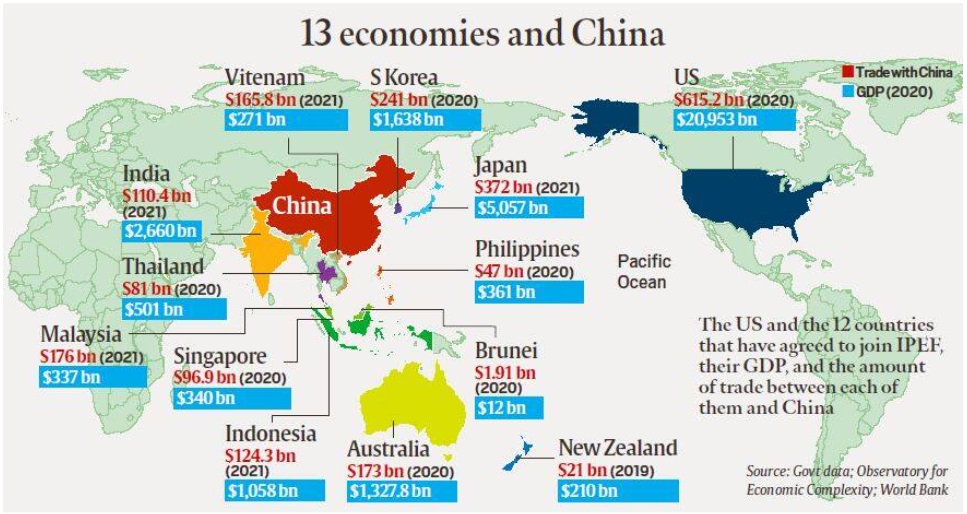Tuesday, 31st May 2022
PM’s gifts for Quad leaders
In News
In an attempt to give a glimpse of India’s rich heritage and culture, the Indian Prime Minister has recently presented gifts to his counterparts and dignitaries from the four Quad nations.
About the News
- The gifts were given during the two-day visit by the PM to attend a summit of the Quad leaders which is aimed at further bolstering cooperation among the member nations of the influential grouping and discussing developments in the Indo-Pacific region.
Various gifts during the visit
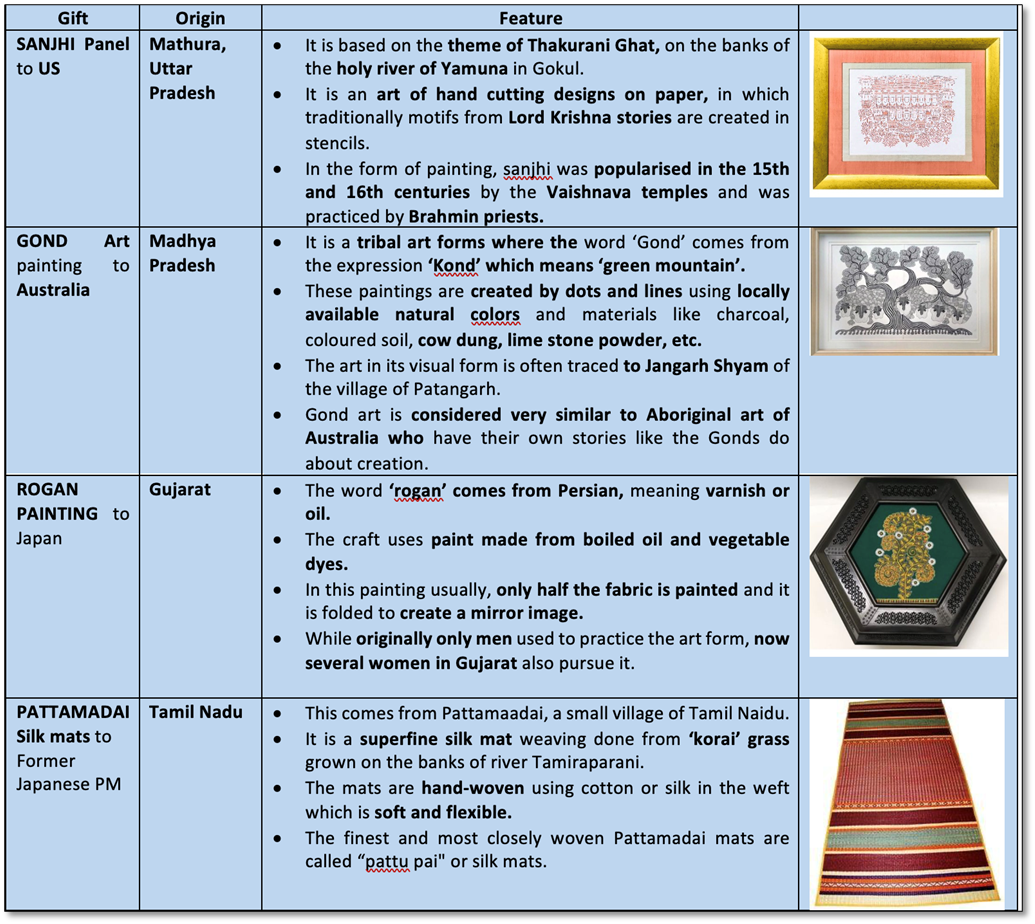
Sources:
Maharashtra overtakes UP in Sugar Production
In News
After a five-year gap, Maharashtra has overtaken Uttar Pradesh (UP) to regain its position as India’s top sugar producer.
About the News
- Maharashtra expects the output of Sugar for the 2021-22 crushing year (October-September) at an all-time-high.

- While other states like Karnataka and Gujarat are also expecting record production of sugar this year, UP’s sugar output is set to fall to a five-year-low in 2021-22.
- This year’s bumper production has been mainly due to Maharashtra, Uttar Pradesh and Karnataka who have contributed around 85 per cent of the total production.
Reasons for rise in Maharashtra’s Sugar Production:
- Bountiful rainfall: Maharashtra has been receiving good rainfall since the 2019 southwest monsoon season (June-September). The filling up of reservoirs and recharged groundwater aquifers has induced farmer to plant more area under sugarcane, which is a 12-18 months duration crop.
- Higher yields due to extra care taken by farmers: Farmers have started employing various measures to improve yield of sugarcane, like planting different types of sugarcane varieties.
- Underreported cane: A huge jump in “unregistered” cane cultivation has meant that there is un-harvested cane still in the fields and mills will continue to crush till the first week of June. In normal years, crushing operations are over by April-end, rarely extending beyond mid-May.
Reasons for fall in UP’s Sugar Production:
- Ethanol Production: UP has become India’s largest ethanol producer, while also achieving the highest blending-in-petrol ratio among all states.
- Crop Losses: There has been crop loss from excess rains and water-logging in many low-lying cane-growing areas of eastern UP.
- Same Variety use: About 87% of UP’s cane area being planted under a single variety, Co-0238. While that variety, helped significantly boost cane yields and sugar recovery in UP from 2013-14, it has become susceptible to red rot fungal disease.
Sources:
Securing the Aadhaar data
In News
The Unique Identification Authority of India (UIDAI) has recently withdrawn its first issued warning to the public of not sharing a photocopy of their Aadhaar with any organisation, in the backdrop of security risk and misuse.
About the news
- The UIDAI, the statutory body mandated to collect Aadhaar data had earlier issued a warning to the “general public not to share photocopy of one’s Aadhaar with any organisation but instead recommended “a masked Aadhaar, which displays only the last four digits of one’s Aadhaar number,” to be used for such purposes.
- It also stated that only those organisations that have obtained a User License from the UIDAI can use Aadhaar to establish the identity of a person and also that that hotels or film halls are not permitted to collect or keep copies of Aadhaar card as it is an offence under the Aadhaar Act 2016.

How to keep one’s Aadhaar data safe?
- Two-factor authentication:It is imperative that one’s Aadhaar is linked to his/her primary mobile number and email ID. This is where UIDAI will send the one-time password (OTP) if someone tries to access one’s Aadhaar account or using it for any verification.
- If one has changed his/her mobile phone number for any reason, it is best to go to an Aadhaar enrolment centre and update this information at once. Aadhaar verification can only happen with this OTP.
- Masked Aadhaar copy: A ‘Masked Aadhaar’ copy can be downloaded from the official UIDAI website and one can then share a photocopy or version of this, instead of the full Aadhaar id. This version only has the last four digits of your Aadhaar number, instead of the full number.
- Locking biometrics: The Aadhaar biometric data, can also be locked from the UIDAI website. When the biometrics (fingerprint, iris, and face) are locked, they can no longer be used for authentication preventing misuse.
- However, OTP-based authentication would continue to be available as needed. Users can lock this data temporarily or permanently, depending on preference, and it can be unlocked in both cases.
- Using VID: The Virtual Identity, or VID, is a system of “Limited KYC” (Know Your Customer). This hides the Aadhaar number from the authenticating agency, while still confirming the identity of the user.
-
- This is a 16-digit number, but temporary in nature. So, unlike the permanent 12-digit Aadhaar number, the VID is valid only for some time.
- The old VID expires when a new one is generated, and only one valid VID number can be there against a particular Aadhaar number at any given point in time.
- VID confirms one’s identity to the authenticating entity, for instance, the bank. The VID can be generated from the Aadhaar resident portal or the mAdhaar app on iOS and Android.
- Users can also go to the Aadhaar website or app to see authentication history to know if the data has been used without their knowledge.
Source:
Image source:
World No Tobacco Day
On May 31, 1987, WHO member countries agreed to observe World No-Tobacco Day on May 31. This day is observed to raise awareness about the damage caused by consuming tobacco.

Tobacco kills over 8 million people every year and destroys our environment, further harming human health, through the cultivation, production, distribution, consumption, and post-consumer waste. For this year, the theme is “Protect The Environment”. Every year, the World Health Organisation honours governments, organisations and individuals for their efforts and contributions to curbing tobacco use. This year, the WHO has selected Jharkhand for the World No Tobacco Day (WNTD) Award-2022.
Sources:
The Wildlife (Protection) Amendment Bill, 2021
In News
A parliamentary panel recently submitted a report on the Wildlife Protection (Amendment) Bill 2021.
About the Bill
- The Wild Life (Protection) Amendment Bill, 2021 was introduced in Lok Sabha by the Minister of Environment, Forest and Climate Change on December 17, 2021.
- The Bill seeks to increase the species protected under the law and implement the Convention on International Trade in Endangered Species of Wild Fauna and Flora (CITES).
Key features of the Bill include
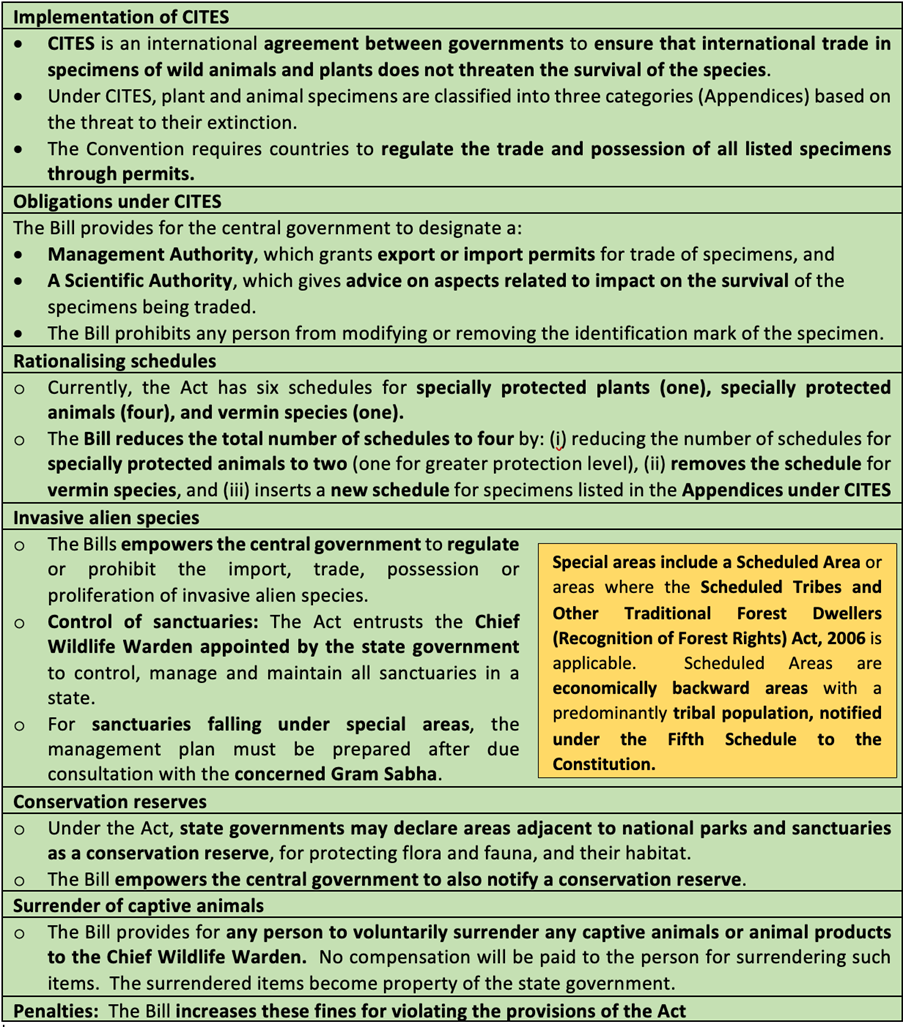
Limitations of the Bill
- The standing committee of the state board for wildlife (SBWL), to be headed by its vice-chairperson, a post to be held by the state’s forest minister would be packed with official members and end up being ineffective against any government projects.
- Provision for trade in live elephants: The bill introduces a new Subsection (4) to Section 43 of the WPA that takes away the protection from trade in live elephants.
- Under sections 40 and 43 of the law, transfer, acquiring and receiving of a live captive elephant is permissible only with the prior approval of the chief wildlife warden.
- Many species are missing from the schedules due to reduction in the number of schedules in the Bill and there are instances where species that should be in Schedule I but have been placed in Schedule II.
- Listing of individual species instead of groups (i.e., all Holothurians, all Signathidians, Testudinidae, Tryonychidae, Horbills etc.) is a major deviation from the current Act, which can give rise to taxonomic ambiguity when identifying species.
- Names of species in the Schedules have been misspelt and incorrect naming of species can lead to confusion and uncertainty during legal proceedings.
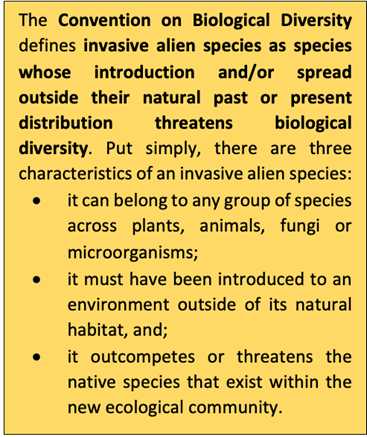
- Inclusion of ‘circus’ within the definition of ‘zoo’ can have a very deleterious effect on conservation, and is against the a draft notification on November 28, 2018, banning the use of all animals in circuses across the country.
- Breeding of Indian native species included within Schedule IV of Draft Amendments raise concerns.
- The Bill takes a narrow definition of invasive alien species as compared to the Convention on Biodiversity (CBD).
- The Bill defines invasive alien as a species of animal or plant which is not native to India and whose introduction or spread may threaten or adversely impact wildlife or its habitat. Thus, it misses on Indian native species which may be invasive in particular environments.
Parliamentary Panel Recommendations
- Non-official members should also be part of the state wildlife board committee proposed to assess infrastructure projects in and around protected areas
- It should include at least three wildlife institutions and the director of the Wildlife Institute of India or his/her nominee.
- The House panel report has recommended the deletion of the clause and provide an explanation of provisions for transport of captive elephants.
- In order to ensure that the objective of providing legislative backing to CITES, without disturbing the prohibitive structure of Wildlife (Protection) Act, 1972 is achieved, a separate law pertaining to CITES be enacted, and certain specific amendments (be made) in the principal Act as well.
- Inclusion of CITES species in the definition of wild animal (should also be made) — to ensure that law enforcement agencies will get jurisdiction to prosecute offences against CITES species.
- The committee has recommended major changes in all the three schedules, and also the restructuring of Schedules I and II in a manner that makes them easy to read and look up.
Conclusion: Wildlife Protection Act is an iconic piece of legislation that has hitherto helped protect the wildlife in the country. Nevertheless, it was riddled with certain loopholes and the Amendment Bill is a step in the right direction, like the inclusion of CITES within the ambit of the Indian legislation. But, the Amendments in the Bill need too be scrutinised well before going forward, so that the Wildlife of the country retains utmost protection as per international norms.
Sources:
- The Wild Life (Protection) Amendment Bill, 2021
- THE WILD LIFE (PROTECTION) AMENDMENT BILL, 2021
- Parliamentary panel suggests changes to Wildlife Protection (amendment) Bill
- How the Van Gujjars perceive the Wildlife Protection Amendment Act, 2021
- Wildlife Protection Amendment Bill 2021 misses the target despite good intentions
- Bill to amend Wild Life Act: Many species missing from schedules, House panel says in report
- Preliminary comments on the Wild Life (Protection) Amendment Bill, 2021
- Parliament panel to adopt report on Wild Life (Protection) Amendment Bill
- Comments on WPA Bill, 2021
- THE WILD LIFE (PROTECTION) AMENDMENT BILL, 2021 VOLUME – II, MEMORANDA SUBMITTED BY INDIVIDUALS/EXPERTS/INSTITUTIONS
Red Wolf
This is image of rare red wolf born in the US. It is a critically endangered species. By 1980, red wolves had almost become extinct in the wild. The last 14 wild red wolves were brought into zoos as part of the Red Wolf Species Survival Plan (SSP) - a collaboration between the US Fish and Wildlife Service and the Association of Zoos and Aquariums (AZA). The red wolf is between the size of a gray wolf and a coyote. Red wolves are carnivores, though their diet can vary depending on what prey is available. Mostly they hunt smaller mammals like raccoons, rabbits, and rodents, along with white-tailed deer.

Within their territory, red wolves will travel up to 20 miles in search of prey. Red wolves communicate through body language, scent marking, and a series of vocalizations.
Sources:
Pangong Tso
- Context: The Ministry of External Affairs has recently confirmed that China is building a second bridge on the Pangong Tso lake.
- Pangong Tso is an endorheic lake (landlocked) that is partly in India’s Ladakh region and partly in Tibet.
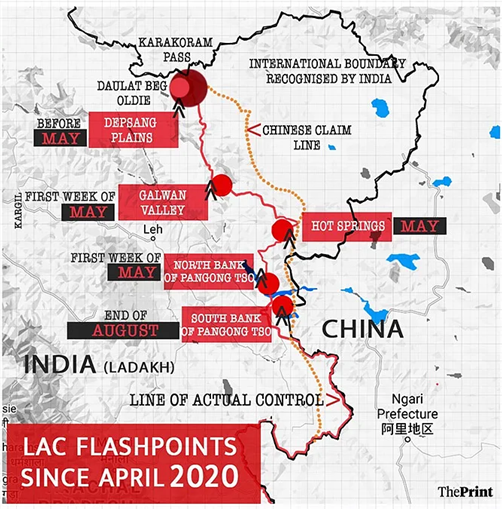
- Pangong in Ladakhi means extensive concavity, the word Tso is Tibetan for lake.
- It is situated at an elevation of about 4,270 m.
- It is 135-km long, and is a narrow lake — 6 km at its widest point; and shaped liked a boomerang, covering a total area of over 600 sq km.
- The Karakoram Mountain range ends at the north bank of Pangong Tso.
- The lake’s water, while crystal clear, is brackish, making it undrinkable.
- Nearly two-thirds of the lake is controlled by China, with just about 45 km under Indian control.
- The LAC, running north-south, cuts the western part of the lake, aligned east-west.
- The southern bank of the lake is important, because it is just north of the Chushul approach (it is one of the few sectors that can be used as launchpads for an offensive, because of the plains).
- While India claims that the LAC passes through Finger 8 on the Northern bank, the Chinese claim it passes further West.
- Hence, the area around Pangong Tso, has become a Military obstacle for India and China, with China willing to extend its boundaries and consolidate in the region.
Source:
- Explained: What China aims to achieve by building a second, bigger bridge on Pangong Tso
- DNA Special: Strategic importance of southern part of Pangong Lak
Image source:
Ayushman Bharat Digital Mission
- Context: The National Health Authority under its flagship scheme of Ayushman Bharat Digital Mission (ABDM) has recently launched a public dashboard for real-time information on the scheme.
- The Ayushman Bharat Digital Mission (ABDM) aims to develop the backbone necessary to support the integrated digital health infrastructure of the country.
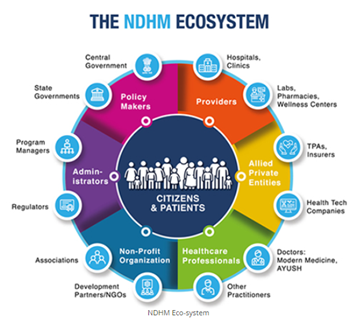
- Building blocks of ABDM include:
- Health ID: to standardize the process of identification of an individual across healthcare providers.
- Healthcare Professionals Registry: to enable them to get connected to India’s digital health ecosystem.
- Health Facility Registry (HFR): A comprehensive repository of health facilities of the nation across different systems of medicine.
- ABHA Mobile App: An electronic record of health-related information on an individual that conforms to nationally recognized interoperability standards and that can be drawn from multiple sources while being managed, shared, and controlled by the individual.
Source:
Image source:
UN Peacekeepers
- Context: The International Day of UN Peacekeepers has been observed on May 29th.
- UN Peacekeeping helps countries navigate the difficult path from conflict to peace.
- UN peacekeepers provide security, political and peacebuilding support to help countries make the difficult yet early transition from conflict to peace.
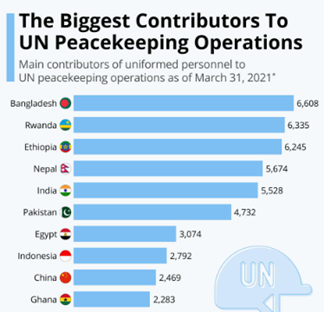
- They are guided by three basic principles:
- Consent of the parties
- Impartiality
- Non-use of force except in self-defence and defence of the mandate
- The first UN peacekeeping mission was established on 29 May 1948, when the Security Council authorized the deployment of a small number of UN military observers to the Middle East, to monitor the Armistice Agreement between Israel and its Arab neighbours.
- The Security Council determines the deployment of a new UN peace operation.
- Presently, in multidimensional operations, the Peacekeepers are also called to facilitate the political process, protect civilians, assist in the disarmament, demobilization and reintegration of former combatants; support the organization of elections, protect and promote human rights and assist in restoring the rule of law.
Source:
- WHAT IS PEACEKEEPING
- External Affairs Minister honours memory of those who have made supreme sacrifice in cause of peace on International Day of UN Peacekeepers
Image source:
Unicorn Startup
- Context: India has recently reached a landmark figure of 100 unicorns with a valuation of more than $300 billion.
- Unicorns are privately held, venture-capital backed startups that have reached a value of $1 billion.
- The term initially was used to lay emphasis on the rarity of such startups.

- The valuation of unicorns is not expressly linked to their current financial performance, but largely based on their growth potential.
- Only a privately held startup can be a unicorn.
- Disruptive Innovation, high on technology, new ideas, consumer focus are some of the common features of unicorns.
- Flipkart, Snapdeal, Zomato, Swiggy are some examples of Unicorns from India.
- The abnormally high valuation, resulting in Unicorns are because of fast-growth strategy, buyouts instead of going for IPO and Innovation leveraging on new technologies.
- The year 2021, 2020, and 2019 saw the birth of the maximum number of Indian unicorns with 44, 11, and 7 unicorns coming each year.
Source:
Image source:
India needs a forward-looking strategy on Pakistan: Indian Express
Essence: The editorial talks about the evolution in India’s strategy in the past 3 decades on how to deal with Pakistan and the factors that determine such engagements. After the cold war period and withdrawal of USSR from Afghanistan, Pakistan was at the helm of affairs with regards to Kashmir issue. There was international pressure on India to sustain dialogue with Pakistan and counter the question on nuclear proliferation. Pakistan used this advantage to destabilize India further, through violent acts of state-sponsored terrorism, and fueling secessionist movements by Hurriyat, often highlighting alleged human right abuses in Kashmir valley. India’s response during those times was gentle, soft, and defensive.
The situation at hand has reversed now. In its quest to win over geopolitics in Afghanistan and redefine political ties with India, Pakistan has lost control of its economy. Now, India is in a stronger position to stop negotiations in case of terrorism/violence acts, possibly eyeing at nuclear escalation for creating credible deterrence, especially after changing the constitutional status of J&K in 2019. Meanwhile, Pakistan is going through the internal political turmoil and changes of rein in the armed forces, which keeps it at backfoot. Thus, this is an expansion in India’s diplomatic and strategic space and contraction for Pakistan on the same fronts.
Why should you read this article?
- To understand the relational dynamics between India and Pakistan in the previous 3 decades.
Source:
Doses of statecraft to meet India’s challenges: The Hindu
Essence: The editorial highlights the need for statecraft with deftness, strength, and agility rather than only resorting to the iron fist strategy or military methods for dealing with security challenges in India. While the world grapples with Ukraine war and socio-political turmoil in South Asia, India goes through continuous security threats at all corners of its geography. Kashmir militancy in north, resurgence of sleeper cells of Khalistan movement, ULFA and Naga independence movement in north-east, left-wing extremism in deep interiors and revival of Tamil sponsored LTTE movements in south India- each of them have been evidenced by India lately. The security forces can deal with the immediate threats (temporary relief), but long-term solution requires the use of statecraft. Understanding the changing nature of threat (online, technology oriented, etc.), each threat being unique and disparate from the other with a separate root cause, and ability to quickly respond to political challenges, requires strategy and policy approach.
The doctrine of containment followed in J&K doesn’t seem to have worked, with the rising violence in the valley in the last 2 years. Maoism is an internal problem with an ideology and brutality in its attack on state forces. It is a confusion to understand if Maoism as a threat is declining or rising with such attacks. Similarly, the rise in terrorism in Punjab is assisted by funds from across the border, i.e. ISI, UK, Europe, Canada, etc. Naga political solution and ULFA revival must be addressed in an inclusive manner and so should the Tamil crisis be, which could receive trigger due to Sri Lankan economic crisis. Statecraft- skillfully handling the issue with a long-term strategy in mind, should be the way forward to handle security issues in and around India.
Why should you read this article?
- To know the security threats challenging India.
- To understand how statecraft could manage the security situation in India.
Source:
Sustainable Boiler
Background
Subhash Ola, the CEO and founder of Geniusenergy Critical Innovation Pvt Ltd, invented a boiler that won the 'Startup of the Year' India award from the 'Amazon Possible Entrepreneurship Challenge.'

About the Invention
- Subhash Ola, a science enthusiast and innovator, a resident of Alwar, Rajasthan who is a school dropout once invented a DC thermal power plant for his no-electricity He began his trials when he was 13 years old.
- The GCI boiler uses the same waste, recycles it, and reuses it. The entire procedure saves a lot of firewood and reduces pollution. These boilers reduce the firewood consumption from 100 kg to 20 kg.
- The system is a closed circuit, so waste steam is never wasted and is recycled. More than 50% of LPG waste can be recycled using the same technology.
Quote: “There must be a better way to make the things we want, a way that doesn’t spoil the sky, or the rain or the land”-Paul McCartney
Source:
Share the article
Get Latest Updates on Offers, Event dates, and free Mentorship sessions.

Get in touch with our Expert Academic Counsellors 👋
FAQs
UPSC Daily Current Affairs focuses on learning current events on a daily basis. An aspirant needs to study regular and updated information about current events, news, and relevant topics that are important for UPSC aspirants. It covers national and international affairs, government policies, socio-economic issues, science and technology advancements, and more.
UPSC Daily Current Affairs provides aspirants with a concise and comprehensive overview of the latest happenings and developments across various fields. It helps aspirants stay updated with current affairs and provides them with valuable insights and analysis, which are essential for answering questions in the UPSC examinations. It enhances their knowledge, analytical skills, and ability to connect current affairs with the UPSC syllabus.
UPSC Daily Current Affairs covers a wide range of topics, including politics, economics, science and technology, environment, social issues, governance, international relations, and more. It offers news summaries, in-depth analyses, editorials, opinion pieces, and relevant study materials. It also provides practice questions and quizzes to help aspirants test their understanding of current affairs.
Edukemy's UPSC Daily Current Affairs can be accessed through:
- UPSC Daily Current Affairs can be accessed through Current Affairs tab at the top of the Main Page of Edukemy.
- Edukemy Mobile app: The Daily Current Affairs can also be access through Edukemy Mobile App.
- Social media: Follow Edukemy’s official social media accounts or pages that provide UPSC Daily Current Affairs updates, including Facebook, Twitter, or Telegram channels.




